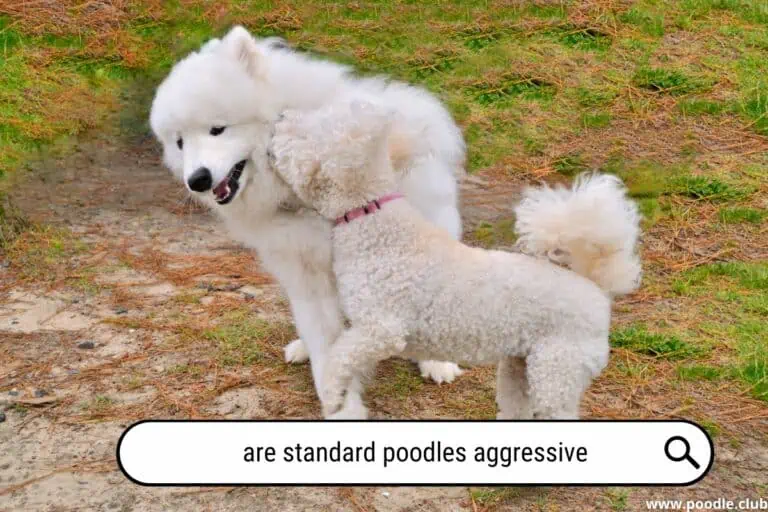Do Poodles Have Webbed Feet [Explained]
The Poodle, recognized for its striking looks and sharp intellect, has a lesser-known feature up its paws – webbed feet! This unique trait, tucked beneath their curlicue coats, offers them a versatile skill set that extends beyond the show ring.

Traditionally, Poodles were hunting aces, specifically bred for retrieving waterfowl. Their webbed feet, thus, play a pivotal role in their history, making them exceptional swimmers and enhancing their overall agility. This surprise element challenges the stereotype of Poodles being simply stylish pets and underlines their hardy nature.
This revelation sheds new light on the beloved Poodle. From their humble beginnings as working hunters to their present-day glory in dog sports and agility events, it’s clear Poodles have more layers than what meets the eye. So, the next time you encounter a Poodle, remember, beneath those charming curls, there’s a hidden adventurer raring to go.
Webbed Feet in Poodles
Structure and Function
Poodles indeed possess webbed feet, a characteristic which sets them apart from some other dog breeds.
These webbed feet consist of a membrane that connects their toes, not entirely dissimilar to the webbed feet of ducks and frogs. The webbing facilitates various functions for poodles, such as swimming and digging. Alongside these functional benefits, their curly coat can also aid poodles in moving through the water.
Benefits for Swimming
Webbed feet in poodles provide numerous advantages when it comes to swimming. They allow poodles to paddle more efficiently and maintain buoyancy in the water. Given their history as water retrievers, this feature is essential. In fact, the “standard poodle” was originally bred for tasks such as retrieving waterfowl. It’s no wonder that poodles excel in canine sports like dock diving and enjoy joining their humans for a splash in the water!
Benefits for Digging
Believe it or not, webbed feet give poodles a leg up in digging as well. The webbing between their toes allows them to move more soil with each dig. It offers them better traction and stability on uneven or slippery surfaces. It’s important to remember, though, that poodles are not a breed known for excessive digging, so your garden should be safe.
PuppySpot is a reputable dog marketplace where you can browse and find compatible puppies right from the comfort of your home. They have placed over 200,000 puppies into homes in the US!
Comparison to Other Breeds
When comparing poodles to other dog breeds, their webbed feet stand out amongst swimmers such as retrievers. However, it’s not exclusive to poodles. Other breeds such as the Newfoundland or the Labrador Retriever have webbed feet too, providing similar benefits for these water-loving canines.
In short, webbed feet are an intriguing aspect of poodles and allow them to enjoy activities like swimming and digging. So, the next time someone asks, “Do poodles have webbed feet?” feel free to flaunt your knowledge and share the perks of their unique paws!
Poodles as Swimmers
Agility and Stamina
Poodles are known for their agility and stamina, which makes them excellent swimmers. They were originally bred for water retrieval, fetching waterfowl for hunters. Their strong legs and powerful tails enable them to easily propel through water, while their high energy and natural athleticism allow them to cover long distances.
Influence of Fur and Coat
One might think that the Poodle’s thick, curly coat would be a hindrance when it comes to swimming. In reality, their coat actually harbors some unique qualities that aid in their water escapades.
Poodles don’t shed like other breeds, which reduces the chances of waterlogged fur. Moreover, their dense curls provide insulation in cold water, allowing them to stay warm and comfortable during swim sessions.
Swimming with Retrievers
It’s no surprise that Poodles enjoy swimming, as they share a common ancestry with other skilled water breeds such as Labrador Retrievers and Golden Retrievers. All three breeds have webbed feet that enhance their swimming abilities by increasing surface area and allowing for more effective paddling while navigating the waters.
Aptitude for Dock Diving
Poodles are naturals at dock diving—a fun and entertaining water-based dog sport involving leaping off a dock and into a body of water. In a splash of bravado, Poodles frequently outshine their canine competitors, further solidifying their status as swimming superstars.
Just remember, if you’re considering a Poodle as your furry companion, don’t be surprised if they’re excited to dive into any body of water, be it the nearest pond or even your bathtub!
Other Dog Breeds with Webbed Feet
Besides poodles, there are several other dog breeds known for their webbed feet. This unique feature helps them to be excellent swimmers and assists in their specific tasks like retrieving and herding.
Portuguese Water Dogs
Portuguese Water Dogs are one of the most famous breeds with webbed feet. They were originally bred to help fishermen with various tasks, such as catching fish and herding them into nets. Their webbed feet made swimming and diving much easier for them, giving fishermen a helping paw in their daily work.
Labradors and Labrador Retrievers
Labradors, including Labrador Retrievers, are also well known for their webbed feet. These breeds are natural hunters and excel at waterfowl retrieving. They’re like the Michael Phelps of the dog world, breaking records in a variety of doggy disciplines including the doggy paddle.
Newfoundlands
Newfoundlands are not only famous for their large size and gentle nature, but also for their impressive swimming skills, which are boosted by their webbed feet. They are known to be expert swimmers and have been used historically for water rescue missions. If you find yourself struggling in the water, a Newfoundland might just be your furry lifesaver!
Dachshunds
Though not the first breed that comes to mind when thinking about swimmers, Dachshunds surprisingly have webbed feet as well! While these little guys who are often mistaken for hotdogs might not be the fastest swimmers, their webbed feet do help them dig and maneuver through the earth, making them excellent burrowers.
Water Spaniels
Water Spaniels, including the Irish Water Spaniel and American Water Spaniel breeds, are also known for their webbed feet. These talented dogs were initially bred as hunting companions in marshy areas and around bodies of water, where their webbed feet became an essential tool for navigating through the wet terrain.
There you have it – a brief and entertaining look at some of the other dog breeds with webbed feet. Life wouldn’t be the same without these amphibious canines by our sides, navigating the water with their extraordinary swimming skills. Now, if only we could borrow some of their talents for our next trip to the beach!
Caring for Webbed Feet
Poodles are known for their intelligent nature and distinct appearance, which includes their unique webbed feet. These feet play a critical role in their history as waterfowl retrievers, making them excellent swimmers. In this section, we will discuss how to care for your poodle’s webbed feet, covering topics such as grooming, infection prevention, and nail clipping.
Grooming
Your poodle’s webbed feet require regular grooming to maintain their health and comfort. Start by gently brushing between the toes to remove any dirt and debris, as poodles don’t typically shed like some other breeds, such as spaniels. Additionally, trim the hair around the feet to prevent tangles, which can lead to discomfort and even infections.
Beware of Infections
Infections are always a risk with webbed feet, as bacteria can easily find its way into the warm, moist environment between your poodle’s toes. To minimize the risk, make sure to dry your dog’s feet thoroughly after a swim or walk in the rain. Keep an eye out for signs of infection, such as redness, swelling, or an unpleasant odor. If you notice any of these symptoms, consult your veterinarian for advice.
Nail Clipping and Care
Regular nail clipping is essential for maintaining your poodle’s foot health. Overgrown nails can cause discomfort, affect the way they walk, and even lead to other issues like ingrown nails. Trim your poodle’s nails every 4-6 weeks, but be careful not to cut the quick, as this can cause pain and bleeding. If you’re unsure about how to clip your dog’s nails properly, consult with your local groomer or veterinarian for guidance.
In conclusion, caring for your poodle’s webbed feet is a vital part of ensuring their overall health and happiness. By following these tips on grooming, infection prevention, and nail clipping, you’ll help keep your furry, intelligent family member in tip-top shape. And who knows? You might even convince them to show off their swimming skills at the next doggie pool party.
Poodle Breed Overview
History and Origin
Poodles, originally bred in Germany, were later popularized in France as water retrievers. Known for their gentle nature and exceptional intelligence, poodles quickly became favored pets among the French nobility. Over time, these dogs have proven their versatility in various roles, from hunting to circus performances.
Sizes and Varieties
Poodles come in three distinct sizes: standard, miniature, and toy. Standard poodles are the largest, typically standing between 15 to 22 inches at the shoulder. Miniature poodles are a bit smaller, usually ranging between 11 to 15 inches, while toy poodles are the smallest, standing at 10 inches or under. The standard poodle was initially bred as a water retriever, while the miniature and toy varieties were later developed to cater to different owners’ preferences.
Physical Features
Poodles are known for their unique, curly coats, which can come in a variety of colors, including solid shades of black, white, and apricot. These dogs are often characterized by their distinctive topknot and well-maintained appearance.
As a breed originally intended for water retrieval, poodles possess a few defining water-friendly traits. These dogs feature long, strong legs and muscular bodies, which allow them to glide gracefully through water. Most notably, poodles have webbed feet, which contribute to their excellent swimming abilities.
While not everyone owns a poodle for their water skills, their intelligence and gentle nature make them popular pets and show dogs. So whether your poodle is diving for ducks or simply fetching tennis balls at the park, their dynamic heritage and charming qualities will surely bring a smile to your face.
Poodle as Family Pets
Temperament
Poodles are known for their friendly and intelligent nature, making them excellent family pets. They are eager to please and learn quickly, making them easy to train for both land and water purposes. Originating from Germany, these dogs were initially bred for hunting ducks, but have since become popular companions for families all around the world.
Versatility
Poodles come in various sizes and have a unique fur coat, consisting of a single layer which helps reduce shedding. This makes them suitable for people with allergies or who prefer less fur around their home. The Connective tissue in their paws provides stability and friction, making them great companions for activities like hiking or playing in the park.
Great Swimmers and Hunting Ability
One lesser-known fact about poodles is their webbed feet, which enable them to be fantastic swimmers. This trait is shared by other water-adapted animals such as otters, bears, and Newfoundlands. The webbing between their toes increases the surface area of their feet, allowing them to propel themselves more efficiently when swimming. This makes them well-suited for hunting waterfowl.
Compatibility with Children and Other Pets
Poodles have a playful and gentle temperament, which makes them great companions for children and other pets. They are often compared to breeds like Weimaraners and Dachshunds for their adaptability to a family setting. However, despite their friendly demeanor, it’s important to remember that poodles can be energetic and may require lots of exercise to keep them happy and healthy.
Remember, just like any other dog, providing your poodle with love, attention, and proper care will ensure they become a loving and loyal addition to your family.







![When Do Poodles Shed Their Puppy Coat? [Age Guide]](https://poodle.club/wp-content/uploads/2022/05/when-do-poodles-shed-their-puppy-coat-768x512.webp)